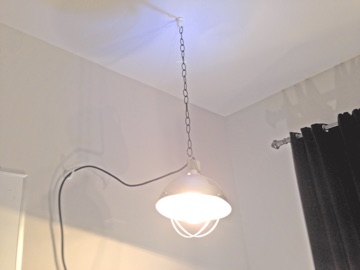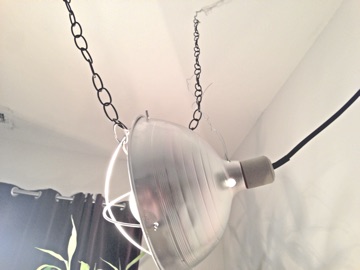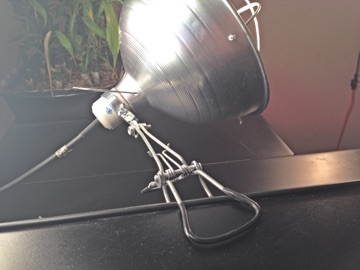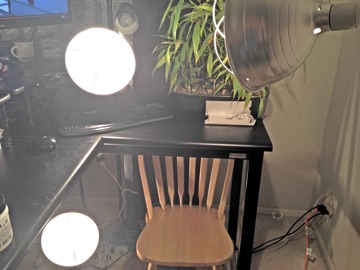As an enthusiast of red light / LLLT therapy, and also a cheapskate that would prefer to avoid spending $36k, I've cobbled together a collection of cheap at-home red light devices for specific purposes.
But first, two quick disclaimers:
- I think my general lighting section is useful for anyone, but the specialized devices in the following sections can have negative effects, so I'd advise against skipping the introductory information.
- I've added my Amazon referral to the Amazon links below. It gives me 4% for linking them at no cost to you.
Jump to:
 Introductory information and resources
Introductory information and resources  Incandescents for general purpose, whole body, feel-good lighting
Incandescents for general purpose, whole body, feel-good lighting  Large LED device for treating specific injuries or inflammation
Large LED device for treating specific injuries or inflammation  Small LED device for smaller targets like thyroid, teeth
Small LED device for smaller targets like thyroid, teeth  Products in the UK, Germany, and elsewhere
Products in the UK, Germany, and elsewhere  Resources for planning treatment sessions:
Resources for planning treatment sessions:
 Introductory information and resources
Introductory information and resources
Does red light therapy sound like something you'd see listed on the crumpled business card of that weird Breatharian guy in your yoga class? Yes. Do many proponents wildly overstate the benefits? Yes. Are skeptics skeptical? Yes. Is it clear that certain types of light have fairly well-studied effects on cells? Yes!Yes. Is it clear that certain types of light do something to cells? Yes!
To get a general overview of the ideas of red light / LLLT, Vladimir Heiskanen's overview is essential reading, particularly the first three sections. After that, I'd suggest skimming through Alex Fergus' overview/FAQ page because it answers a lot of the corner-case questions people tend to have.
From there, you may just be interested in skipping ahead to my general feel-good lighting section. But if you want to treat something specific with the more specialized devices, I'd suggest reading this article on "dosing" carefully, keeping in mind the concept that too high a dose can undo the good the light therapy was doing, or even become harmful.
Some additional learning resources:
- I've already mentioned Vladimir's overview page, but his research collection, Patreon, and Facebook discussion group are indispensable as well.
- Resonant FM has the best articles on the specifics of light therapy, and how to treat particular conditions.
- Scott Roberts on heelspurs.com has a lot of technical information, and was the inspiration for me using the security lighting fixtures.
 Incandescents for general purpose, whole body, feel-good lighting
Incandescents for general purpose, whole body, feel-good lighting
I use an approach mentioned by Ray Peat, with high-wattage incandescent lights as "personal lighting" in places where you'll be generally stationary, like desks or couches. Using 130V bulbs run on 120V North American household electricity shifts them more in the direction of the red part of the spectrum, and using brooder enclosures lets you safely run high-wattage lights angled directly towards your body.
This isn't what's usually meant by "red light therapy", but it makes for nice cheerful lighting while also containing some of the beneficial wavelengths in the more-specialized devices.
Bulb selection
I now order my bulbs online because they've become difficult to find locally. I specifically use:
 | PLT 200PS30 from 1000bulbs.com. You can get six (with shipping) for around $30. |
If you plan to use it near your face or around children or pets: These bulbs get very hot, and I had one shatter violently when it was hit with a tiny spritz of juice from an orange. So for any use where hot shards of glass would be more than inconvenient, I'd suggest the shatter-resistant version (thanks to Adam Capriola for finding this!).
If you look to purchase bulbs elsewhere, I'd suggest making sure they're:
- Clear/uncoated, except for silicone shatter-resistance coatings.
- High-wattage. I tend to feel better in very bright light, around 600 watts total. You can substitute a higher numbers of lower-wattage bulbs for the same effect, but this can be more expensive and cumbersome.
- 130V. This isn't essential, but appears to produce more of the beneficial parts of the spectrum, and also makes the bulbs last longer.
- "Medium base" listed in the description. This means it fits in normal sockets. It may also be referred to as an E26/E27 or "standard" base.
- Any shape code. These are the codes starting with "A" or "PS" followed by a number. They just describe the size and shape of the glass part of the bulb, so as long as the bulb's shape looks like it will have plenty of airflow in your fixture, any code is fine.
Fixture selection
The actual fixtures you put the bulbs in are not important, as long as they are rated for the wattage of the bulbs you are using. Most household fixtures will be a fire hazard when used with high wattage bulbs, both because of the heat emanated from the bulb and the amount of power drawn.
Brooder fixtures
I use chicken brooder fixtures because they're inexpensive, easy to "point," and let me pretend I'm a farm animal. These are often available at big box hardware stores like Lowe's or Home Depot, typically in the $15-$20 range. If you order on Amazon, I'd suggest this one:
 | Bayco SL-302B3. It's rated for up to 300 watts. You can also downsize to 150 watt products if you're using smaller bulbs. They also offer a baffling home installation service, the price of which suggests I need a career in brooder lamp installation. |
Here's a few ideas on arranging them:




Photography light stands
If my approach of hanging the lights with chains and clamps alarms you, the older style photography light stands are a good option (thanks Marco!). However, they're becoming harder to find. Here's the only one I could find on Amazon:
 | RPS Studio Kit |
Adam Capriola has also made a do-it-yourself adjustable stand guide that should be very inexpensive to make:
 | DIY PVC light stand |
 Large LED device for treating specific injuries or inflammation
Large LED device for treating specific injuries or inflammation
These devices have a light panel that's about 4x2.5 inches. Resonant FM tested a nearly-identical device at around 45mW/cm2 (a useful amount of output) from the outside of the frame, typical of how you'd use it if it was resting on your body. That will drop off significantly at a distance, and there's no guarantee that the device you receive will be the same.
Ordering
The device plus a power adapter should run less than $40. I ordered this one off Amazon:
 | Aweek 96 LEDs IR Illuminator |
Depending on where you buy the illuminator, it may not come with a power adapter. You can probably save some money here with less-expensive options, but I go with a higher-amp, regulated power adapter in an attempt to prolong the life of both the adapter and the device. This is the most-affordable one I could find on Amazon:
 | CMVision Power Adapter |
Setup
 Small LED device for smaller targets like thyroid, teeth
Small LED device for smaller targets like thyroid, teeth
These devices have a light panel that's just under 2 inches in diameter. Resonant FM tested what is likely the same device at around 100-140mW/cm2 from the outside of the frame (typical of how you'd use it if it was resting on your body). The same disclaimers I mentioned in the larger device section apply to this one.
I've been experimenting with using on my teeth/gums and thyroid.
Ordering
The device plus a power adapter should run around $15. Here's the Amazon option:
 | 48 LEDs IR Illuminator (currently $12) |
Depending on where you buy the illuminator, it may not come with a power adapter. I'd suggest the same one as I did for the larger device.
Setup
 UK, Germany, and elsewhere
UK, Germany, and elsewhere
UK
- Red Light Man has powerful devices in the £160 range.
- Resonant FM has incandescent and LED buyer's guides.
- Chris has several suggestions on Reddit.
- There's some sources mentioned in this forum thread.
Germany
- This forum thread has some German product discussion.
Other countries
If you find good product options in your country, please let me know in the comments.
 Resources for planning treatment sessions
Resources for planning treatment sessions
Hypothyroidism, thyroid autoimmunity
I like Valtu's hypothyroidism article, and all of ResonantFM's articles on thyroid function and light:
- Light And Hypothyroidism - Cure Or Cause?
- Pulsed Light Treatment of Hypothyroidism - Part I
- Laser Treatment Of Hypothyroidism - Part II
- Light Treatment Of Hypothyroidism – Is It Possible With LEDs?
- The Pulsed Laser Treatment Of Hypothyroidism And Heart Disease
There's also a neverending forum thread discussing people's experience treating hypothyroidism with it.
Pain and inflammation
This section is a bit of a placeholder because I haven't yet found a good general beginners guide to pain/inflammation treatment, but Resonant FM has a worthwhile read specifically for shoulder pain. However, it probably requires higher-end devices.
Testosterone
There's a long discussion here about people trying red light on the testicles to improve testosterone levels. However, I strongly suggest reading the cautionary threads here and here, particularly Sucrates' comments.
Oral health
Red Light Man has an accessible overview of the oral health studies.
Hair loss
It seems like there's a ton of interest in red light for hair loss, but I haven't come across across any good all-in-one guides. But here's a few resources from my notes:
- This review study seems like a great overview of the science so far.
- This isn't directly related to red light, but my online pal Danny Roddy writes a lot about "bioenergetic" approaches to hair loss.
- Here is an enthusastic (and that's an understatement) guy's site about laser therapy. He seems to be knowledgeable about planning doses and sessions, and also has DIY and premade laser helmets if you want to look like a cyborg.
Rheumatoid arthritis
As usual, Resonant FM has a great article on rheumatoid arthritis treatment.
Other conditions
Vladimir's ridiculously-huge spreadsheet with 3800+ studies is bound to have something to give you a lead on how a particular condition has been treated before, and whether the treatment was successful. Topics include acne, Alzheimer's disease, arthritis, autism, bone repair, brain injury, carpal tunnel, cellulite, cerebral palsy, circulation, cognitive performance, colitis, depression, diabetes, diabetic retinopathy, dry eyes, fibromyalgia, fractures, glaucoma, hearing loss, herpes, hypertension, inflammation, liver cirrhosis, macular degeneration, metabolism, microbiota, migraines, multiple sclerosis, myopia, osteoporosis, Parkinson's disease, psoriasis, Raynaud's syndrome, rosacea, scleroderma, stroke, tendinitis, tinnitus, and vitiligo.
Believe it or not, I really shortened that list of topics.

Comments
Please leave a comment if you see a way to improve this page or if you have any questions. Keep in mind that I know little about the medical side of bloodwork, I just enjoy making sites with lists of things.
Load comments